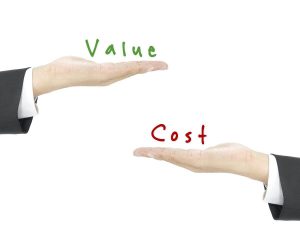How to Increase the Value of Your Business

Reducing costs can help you increase cash flow and, as a result, the value of your business.
The value of a business is based on two factors: the expected future cash flow of the business and the risk that future cash flow will occur when and in the amounts expected.
Cash flow and risk are the meat and potatoes of business valuation. The valuation report that is produced is just a detailed analysis of these factors.
What is future cash flow?
It is the amount of cash available for periodic distribution, plus the amount that will be received from the sale of the company, whenever that sale is expected to occur. This is no different than considering the purchase of 100 shares of stock of a public company. The factors in that consideration are the dividend payment and price appreciation—what the stock will be worth when you are ready to sell it. If you think the stock price will go up, you buy it; if you think it will go down, you don’t.
What is risk?
Risk is the likelihood that the expected cash flow and distributions will not occur, or the company value will either remain static or will decrease. Staying with the 100 shares example, the risk is that the company in which you purchased stock experiences a decline in profits and stops paying dividends, or the stock price goes down and the shares are sold for less than the amount you paid for them. If the investment has a higher risk, the typical investor will demand a higher return as compensation for taking that risk. This higher return is achieved by paying a lower price for the investment.
How can you increase the value of your company?
Back to our two key factors: by increasing cash flow, and reducing risk!
You may be thinking that you are already doing everything you can; what else can you do to improve cash flow?
- Increasing profitability by reducing expenses is the most obvious step. Take a look at your controllable operating expenses and see where you can cut or do things differently to save money right away.
- Improving accounts receivable collections will also yield quick results.
- For example, if your company’s sales are $100,000 per month and your customers’ average payment period is 60 days, your accounts receivable average $200,000. If you can reduce the payment period to 45 days, average accounts receivable will drop to $150,000 and your company will have $50,000 more in cash.
- Managing your inventory will also have a positive result on company cash flow.
- Does your company have any slow moving or obsolete inventory? Or, do you have too much inventory on-hand for your expected sales? If the answer to either of these questions is yes, you have money tied up in inventory that could be in cash or put to more productive use in the business. It is better to dispose of obsolete inventory at reduced prices than continue to tie up cash and incur carrying costs to keep it.
What are the risks that are specific to your business and how can they be reduced?
Customer or supplier concentration, dependence on key employees, changes in marketplace conditions, and poor accounting records are just a few of the risks that may reduce the business value. Every business is different. What risks would a potential buyer of your business be concerned about? Do you have concerns now about your company’s future cash flow or risk?



